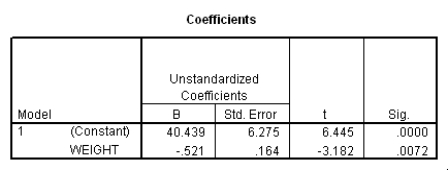Asked by Mallory Sheets on Apr 25, 2024

Verified
Do heavier cars use more gasoline? To answer this question,a researcher randomly selected 15 cars.He collected their weight (in hundreds of pounds) and the mileage (MPG) for each car.From a scatter plot made with the data,a linear model seemed appropriate.The following output was obtained from SPSS: 
 Which of the following descriptions of the value of the slope is the correct description?
Which of the following descriptions of the value of the slope is the correct description?
A) We cannot interpret the slope because we cannot have a negative weight of a car.
B) We estimate the mileage to decrease by 0.521 miles per gallon when the weight of a car increases by 1 pound.
C) We estimate the mileage to decrease by 0.521 miles per gallon when the weight of a car increases by 100 pounds.
D) We estimate the mileage to decrease by 52.1 miles per gallon when the weight of a car increases by 100 pounds.
Mileage
Indicates the distance that a vehicle can travel per unit of fuel.
Slope
A measure of the steepness or incline of a line, indicating the rate at which one variable changes with respect to another.
Weight Of A Car
The total mass of a vehicle, typically measured in pounds or kilograms, which can affect its performance, fuel efficiency, and handling.
- Decode and comprehend the elements of slope and intercept pertaining to a regression line.

Verified Answer

Learning Objectives
- Decode and comprehend the elements of slope and intercept pertaining to a regression line.
Related questions
A Regression Analysis Between Weight (Y in Pounds) and Height ...
In a Simple Linear Regression Problem, the Following Statistics Are ...
One of the Important Factors Determining a Car's Fuel Efficiency ...
Ten Ford Escort Classified Ads Were Selected A) \(\hat{\text { price ...
The Relationship Between Two Quantities X and Y Is Examined ...